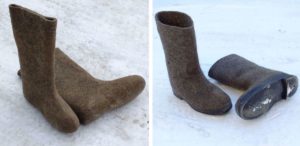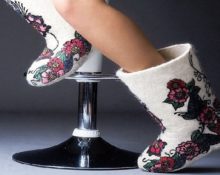 Currently, shoe stores have a huge assortment of different products on the shelves. Among them you can also find felt boots.
Currently, shoe stores have a huge assortment of different products on the shelves. Among them you can also find felt boots.
Previously, it was impossible to find a house in which these shoes would not be on the threshold. They are very comfortable, warm and practical, no laces or locks, put them on and go.
Such shoes have been famous in Rus' since ancient times. And today they remain popular, including as children's shoes. However, mothers of babies often ask whether felted boots get wet. Let's look into this issue together.
Can felt boots get wet?

Felt boots are made from wool, which allows them to keep feet warm even in very cold weather. Wool tends to repel water. This can be noticed by simple observation. If you spill water on a wool surface, it simply flows off. However, this is not always the case. The condition of shoes largely depends on weather conditions.
In the cold
Severe frost is the most favorable weather for felt boots. In such weather, the snow does not stick to the shoes, which means the soles will not become damp.Even if you walk through snowdrifts, at home it is enough to simply shake off the snow with a broom, without allowing it to melt on the surface of your shoes.
In wet snow
Spring and autumn are not the best time for such shoes. In slush, the snow is damp, which means it will stick to the sole, which will lead to getting wet. In such conditions, woolen products, like a sponge, begin to absorb moisture.
Important! With prolonged contact with water, felted products begin to get wet.
How to protect felt boots from getting wet

It is very unpleasant if your shoes get wet. So it will quickly become unusable. But all this can be avoided if you follow simple steps to protect products from moisture.
- The most famous way to protect against getting wet is galoshes.. Galoshes are worn over the shoes to keep them dry. But at the same time stability is lost, since Galoshes are made of rubber and are not intended for walking on ice and slippery surfaces.
- Hemming a second sole from old felt boots is also a very common way to protect against getting wet.. If there is another pair that is no longer used, the required part is cut out of them. It must match the size of the sole. The cut out element is sewn on. This will allow you to stay outside longer during thaws and wet snow.
- Rubber sole is the most practical option for water protection. The felt boots can be taken to the workshop. And if you have old shoes, you can cut the rubber sole out of it and sew it on yourself. Nowadays you can often find felt boots in stores that already have rubber soles.
- There are also non-standard solutions for protection from getting wet, for example, applying silicone sealant to the sole. To do this, you need to dry the felt boots and brush the feet of the shoes with a wire brush.Next, gradually apply the mixture, while rubbing the silicone over the entire surface of the foot. At the end of the work, place the felt boots with your feet up or put them on the legs of an inverted chair until the sealant has completely dried.
Important! Methods of protection using silicone and additional felted soles are short-lived. If any wear or moisture is found, replace them.
Thus, in severe frosts, the felt boots will not get wet and will allow their owner to stay warm. But you shouldn’t wear them on melted snow.


 0
0





